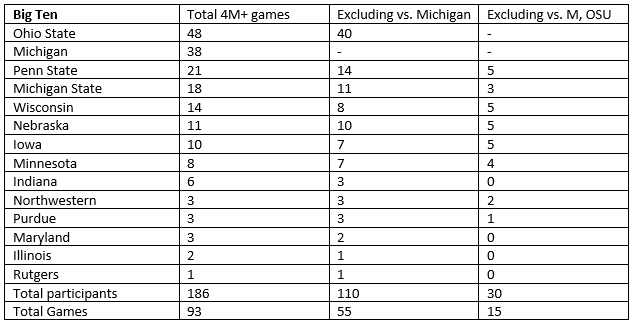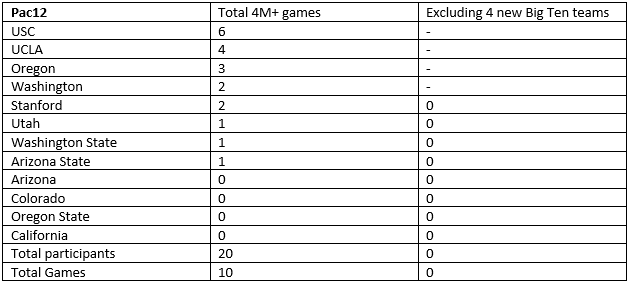TV Viewership by Team
A recent mgoboard post brought up the topic of TV viewership in the Big Ten, with a specific focus on games that command at least 4 million viewers; a number widely considered to be the benchmark TV executives aim to achieve. Recent discussion on whether Michigan should re-consider their membership in the conference can point to this information as an argument in favor of pursuing a different arrangement. Essentially, Michigan (and to a greater extent, Ohio State, and to a lesser extent, Penn State, Wisconsin, and Nebraska) subsidizes the lack of TV interest in the rest of the conference. Using data provided by Sports Media Watch, I’ve analyzed the ratings for Big Ten regular season games from the 2014 through 2022 seasons, and a clear divide can be seen.
Total Big Ten conference games: 392
Games above 4 million viewers: 93
Games above 10 million viewers: 8 (7 were Michigan vs Ohio State, the other was MSU at OSU in 2015. *Also noteworthy is that only 4 of the 9 Big Ten championship games in this span have eclipsed 10 million viewers; 2 involved Ohio State and 2 involved Michigan)
Games above 4 million viewers involving:
Michigan and Ohio State: 8 (every time they’ve met since 2014)
Michigan but not Ohio State: 30
Ohio State but not Michigan: 40
Penn State but not Ohio State or Michigan: 5
Wisconsin but not Michigan, Ohio State, or Penn State: 4
Nebraska, but not Michigan, Ohio State, Penn State, or Wisconsin: 4
The other 2 games above 4 million viewers were MSU vs Purdue in 2021, and Minnesota vs Iowa in 2019.
Here’s a full breakdown of the Big Ten conference games above 4 million viewers (note that the total is 186, representing two participants in each of the 93 games):
The impact Michigan has on Big Ten viewership is significant. Of the 93 “highly viewed” games, 38 involved Michigan, or about 41%. For reference, I also checked out games between the 4 incoming Pac12 teams over this time span, to see if they could “replace” Michigan. In short, no:
Total regular season Pac12 games: 303
Pac12 games above 4 million viewers: 10 (all 10 featured at least one of the four Pac12 to Big Ten newcomers, and 5 of the 10 were between two of the four newcomers)
Regular season games between a Pac12 newcomer and current Big Ten team and above 4 million viewers: 5 (out of 9 matchups)
Here’s the breakdown of the other Power 5 conferences:
*Notre Dame had 17 regular season 4M+ games outside of the ACC for a total of 29 4M+ games.
A conclusion to draw from this is that each conference is carried heavily by a couple teams at the top, with the possible exception of the Pac12 where no team really separated themselves from the pack. It may also explain the abrupt demise of the Pac12, as they lagged far behind the other 4 conferences in terms of highly viewed games.
The Big Ten is so dependent on Ohio State and Michigan that the residual effect on other teams in their division is quite noticeable. Excluding games against Ohio State and Michigan, Penn State and Michigan State command similar viewership to the top half of the Big Ten’s west division teams. The data suggests that without Michigan, the Big Ten would still be the 2nd strongest conference in terms of TV viewership, but a much more distant 2nd to the SEC. Without both Michigan and Ohio State, the Big Ten would fall to 4th and dangerously close to the Pac12 level of viewership.
It is safe to assume TV executives are aware of these numbers, and likely have delved much further into the analysis of them. This will be important in the next round of TV contracts for these conferences, as we might see not so much a realignment as a complete re-shuffling of the deck to optimize TV viewership. Teams can be separated into a top tier, 2nd tier, 3rd tier, and desirable leftovers using this data.
Top tier: At least 29 4M+ games, and a clear driver of viewership for their conference. These teams could each anchor their own conference without concern. This tier includes 5 teams: Alabama, Ohio State, Michigan, Georgia, and Notre Dame.
2nd tier: At least 10 4M+ games, and at least 5 without the aid of a top tier team. These teams would be highly desirable to include in new super leagues to maximize TV viewership, but may struggle as a conference flagship team. This tier includes 14 teams: Clemson, Florida State, Oklahoma, Texas, Auburn, LSU, Florida, Tennessee, Texas A&M, Mississippi State, Penn State, Wisconsin, Iowa, and Nebraska.
3rd tier: At least 5 4M+ games, and at least 1 without the aid of a top tier team. These would help fill out the super leagues to create complete schedules. This tier includes 11 teams: Miami (YTM), Louisville, Baylor, Oklahoma State, TCU, Ole Miss, Arkansas, Kentucky, USC, Michigan State, and Minnesota.
Desirable leftovers: Didn’t reach the TV criteria on their own, but placed in a new loaded conference would be very likely to draw big numbers. This tier includes 4 teams: UCLA, Oregon, Washington, and West Virginia.
These 34 teams would be very enticing for forming two 17 team super leagues, keeping only the SEC and Big Ten conference names and preserving a huge number of rivalries by keeping conference foes together.
Super Big Ten (Big Ten, ACC, and Pac12): Ohio State, Michigan, Notre Dame, Clemson, Florida State, Miami (YTM), Louisville, Penn State, Wisconsin, Iowa, Nebraska, USC, Michigan State, Minnesota, UCLA, Oregon, and Washington.
Super SEC (SEC and Big XII): Alabama, Georgia, Oklahoma, Oklahoma State, Texas, Auburn, LSU, Florida, Tennessee, Texas A&M, Ole Miss, Mississippi State, Baylor, TCU, Arkansas, Kentucky, and West Virginia.
No divisions, 9 conference games (2 protected rivals, 7 of the remaining 14 one year, the other 7 the next year), 2 crossover games with the other super league (one home, one away), a 12th game against a team outside the super leagues. Each super league hosts a 4-team conference playoff, the champions of each league meet in the national championship, bowl games pick from the remaining 32 teams or non-super league teams. I think we’re heading towards a variation of this in the next 10 years as the current Big Ten and SEC TV deals expire, and the ACC deal gets close enough to its termination that the exit fee is manageable.
November 17th, 2023 at 10:01 AM ^
LOVE this. Great work!!!
Two thoughts,
I wonder how much a of boost the new PAC members will get playing in better time slots (besides the bump from playing: OSU/Michigan > PSU, Nebraska, Wisconsin, Iowa > MSU, Minnesota).
Next round of expansion regarding the ACC (excluding Notre Dame), looks like FSU and Miami (Miami due to AAU accreditation and TOTAL recruiting hot bed). +/- Clemson (obviously great numbers, but don't know about cultural fit and those numbers are skewed by their recent historical run)
November 17th, 2023 at 11:14 AM ^
I think when the PAC teams play in the old BIG footprint, they will get a better viewership. The same would be true when Michigan/OSU/PSU visits them. Other old B1G teams, may be not as much.
November 17th, 2023 at 11:23 AM ^
Thanks! This was my first diary post and of course I goofed up getting the charts to load in the post itself (hopefully scrolling back and forth to see them in the comments isn't too annoying).
I agree that the new PAC members will get a boost both from better time slots and better matchups, and I think the reason those 4 were targeted by the Big Ten becomes very clear when you look at this data; they were featured in all of the Pac12's 4M+ viewer games in this time frame.
The next round of TV contracts I think will be fascinating. The Big Ten's contract runs through the 2029-30 athletic year (so it expires just prior to the 2030 football season). The SEC's new contract with ESPN/ABC begins next year and runs through the 2033 season. The ACC's is through the 2036 season, and the Big 12's is through the 2030 season. I'd expect we start hearing about upcoming movements sometime around 2028, with the Big Ten likely to make the first move.
The next few seasons may shake up a few teams I'm currently projecting to be barely in and a few that are currently projected to be left out. The biggest wild card is Colorado, as their viewership numbers have been much higher since Deion signed on; they were essentially irrelevant to this conversation before this season. If Deion sticks around and gets them rolling they would certainly be an appealing addition to the Big Ten. South Carolina and all 4 of the ACC's North Carolina teams not making the cut was surprising; I think there's room for a few of them to work their way in before the next wave of re-alignment.
November 17th, 2023 at 1:41 PM ^
Yeah great work on this compilation.
I suppose you included the Covid year. Our canceled games with Iowa & Ohio, plus the UCLA game last year woulda likely kicked our total number up a few.
November 17th, 2023 at 3:59 PM ^
Yes, I did include the 2020 season. This probably affected the numbers a bit, but I don't think it would change the overall conclusion much (there were 62 4M+ regular season games in 2020; the next lowest season was 2017 with 66, and the highest was 2014 with 98). I plan to keep tracking this annually, so it will be interesting to see how steadily the tiers hold leading into the next wave of realignment.
I'm also curious how streaming will factor in going forward, as those numbers are not made publicly available. Additionally, a few networks choose not to participate in collecting ratings. From the source data's website:
Why are there no ratings for SEC Network, ACC Network and more?
The television networks pay Nielsen to measure viewership for their events. In some cases, they may choose not to.
The major networks are all included, so it's likely only a couple (if any) 4M+ games are being left out.
November 17th, 2023 at 10:20 AM ^
Proves that truck drivers do go home occasionally.
November 17th, 2023 at 11:10 AM ^
Fuck Baylor though





Comments